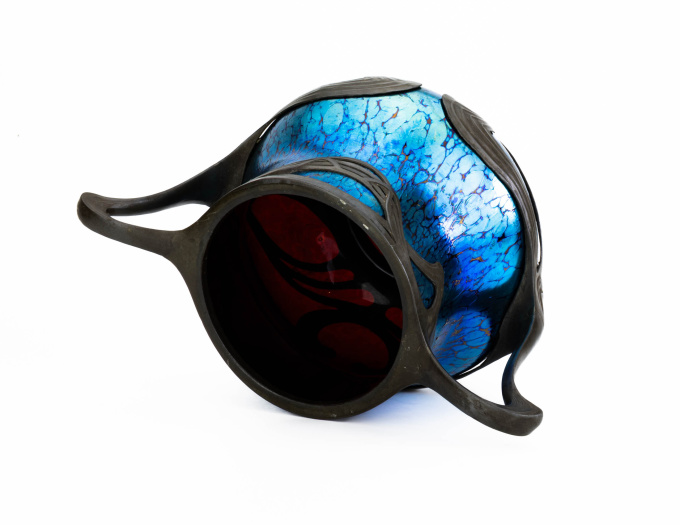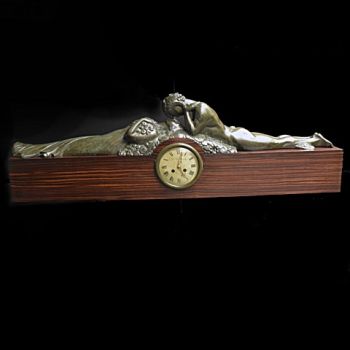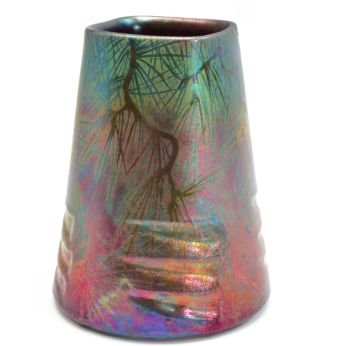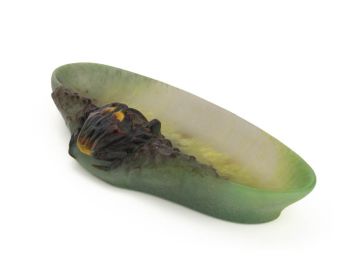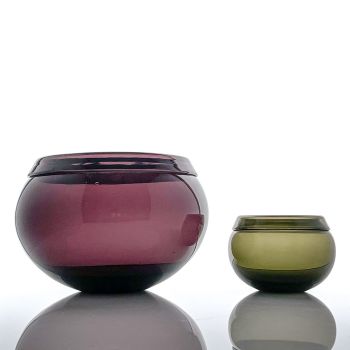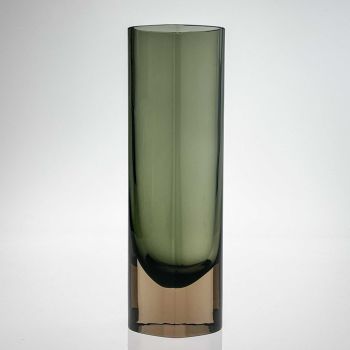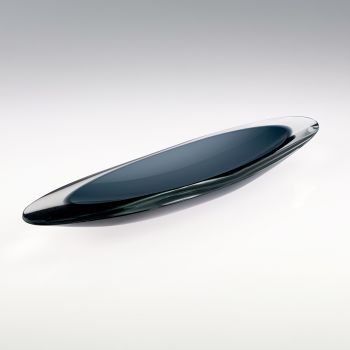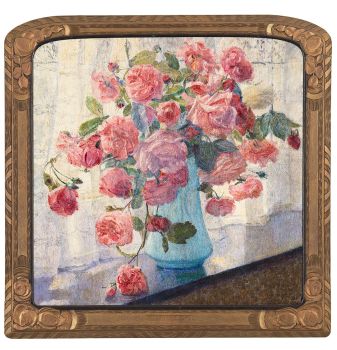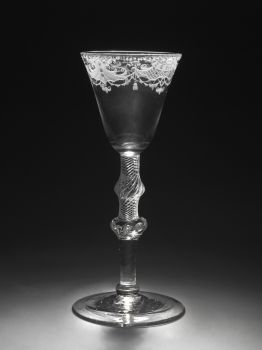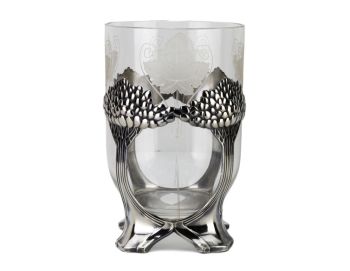Johann Loetz Witwe – Boudon & Klähr, Paris, 1900 – Ruby Papillon – Art Nouveau mount 1900 - 1909
Johann Loetz (Lötz) Witwe Klostermühle
Glas
17 ⨯ 13 cm
ConditionMint
Preis auf Anfrage
Antiques Emporium
- Über KunstwerkThis vase is our second mounted vase from Boudon & Klähr in Paris. This vase or bowl was created in the heyday of Art Nouveau around 1900 – 1905 through a collaboration between Johann Loetz Witwe from Austrian Bohemia and Boudon & Klähr from Paris. This creation is a perfect marriage of Austrian Jugendstil and French Art Nouveau.
The vase was blown by Johann Loetz Witwe in a ground color of ruby red glass and is executed in the decor “Papillon”. This decor made its appearance in the year 1898 and is one of the most famous, successful and probably also one of the most applied decors by Johann Loetz Witwe. Papillon is characterized by iridescent dots that change color depending on which ground color the vase is blown (Crete, Candia, Cobalt or Ruby).
Boudon & Klähr which was based in Paris represented Johann Loetz Witwe’s glass in the French capital. This vase that was sold exclusively by Boudon & Klähr, therefore, is an excellent representation of Austrian Art Nouveau glass combined with a pewter mount in French Art Nouveau design.
The literature indicates that the glass for this vase was commission-ordered from Johann Loetz Witwe by Boudon & Klähr; it is unknown by which firm the pewter frame was applied to the commission-ordered vases. In some cases Gustav Gurschner is attributed as the designer, although no incontrovertible evidence for this has been found.
Dimensions:
Height: 175mm / 6.89”
Diameter top: 130mm / 5.12″
Width mount: 265mm / 10.43″
Literature:
Prestel – Böhmisch Glas 1880 – 1940 Band 1 Werkmonographie. Page 98 & 99. - Über Künstler
Etwas mehr als hundert Jahre existierte die Glashütte Lötz in Klostermühle, Österreich, ab 1840. Ihre Blütezeit erlebte sie jedoch zu Lebzeiten von Max Ritter von Spaun, dem Enkel des ursprünglichen Gründers Johann Lötz.
Von Spaun übernahm 1879 das Unternehmen und führte es bis 1908, ein Jahr vor seinem Tod. Er wurde von seinem technischen Spezialisten Eduard Prochaska unterstützt, und gemeinsam erfanden, entwarfen und produzierten sie eine ganze Reihe wunderbarer neuer Glasarten, erwarben mehrere Patente und gewannen Preise auf allen großen Weltausstellungen in den 1890er Jahren und in den ersten Jahren des 19. das neue Jahrhundert.
Die Firma Loetz gehörte zu den Vorreitern im Jugendstildesign und insbesondere im Bereich des schillernden Kunstglases. "Papillon"-Glas, wie die Vase links, wird heute manchmal als "Ölfleck"-Glas bezeichnet. Eine weitere beliebte Farbe von Loetz war bestrahltes Glas mit gezogenen Spuren, das als "Phenomenon" -Glas bezeichnet wird.
Es gab irritierte Vasen mit Bändern in Metallic-Farben, die sich über die Oberfläche schlängelten, und viele spektakuläre Designs mit applizierten Pfaden in schönen Farben oder einfach aus dem Glaskörper herausgezogen, um Griffe oder Dekorationen zu bilden.
Um 1900 begann das Unternehmen mit externen Designern zusammenzuarbeiten, und einige große Künstler entwarfen Stücke für Lotz, insbesondere Joseph Hofmann, Koloman Moser, Maria Kirchner und Hofstatter.
1908 wurde Loetz von Max von Spauns Sohn, auch Max genannt, übernommen, und obwohl es finanziell zu kämpfen hatte (Konkurs 1911 und erneut 1931), gab es mehrere große Designer, deren Arbeiten in diesen Jahren und durch die Kunst von Loetz produziert wurden Deko-Zeit. Dazu gehörten Adolf Beckert und Michael Powolny.
Sind Sie daran interessiert, dieses Kunstwerk zu kaufen?
Artwork details
Related artworks
Johann Loetz (Lötz) Witwe Klostermühle
Johann Loetz Witwe - Phänomen Genre 7773 – Orange1900 - 1910
Precio a consultarAntiques Emporium
Johann Loetz (Lötz) Witwe Klostermühle
Johann Loetz Witwe – Jugendstil Cobalt Papillon vaas1900 - 1910
Precio a consultarAntiques Emporium
Johann Loetz (Lötz) Witwe Klostermühle
Johann Loetz Witwe – Ausfuehrung 146 Titania vase – 19121910 - 1919
Precio a consultarAntiques Emporium
1 - 4 / 7- 1 - 4 / 24
Johann Loetz (Lötz) Witwe Klostermühle
Johann Loetz Witwe - Phänomen Genre 7773 – Orange1900 - 1910
Precio a consultarAntiques Emporium
Gabriel Argy-Rousseau
Gabriël Argy-Rousseau – Crabes et Algues vase – 19201920 - 1929
Precio a consultarAntiques Emporium
Artista Desconocido
François-Théodore Legras – Tall “Fleurs de Pommier” apple blossoms vase1900 - 1909
Precio a consultarAntiques Emporium
Amalric Walter
Amalric Walter & Henri Bergé – Crabe plumier1920 - 1929
Precio a consultarAntiques Emporium
1 - 4 / 24Artista Desconocido
Japanese art deco lacquervase with Scarab beetle motif1920 - 1950
Precio a consultarDille Art
Herman Bogman jr.
Flower still life of a nasturtium in a blue vase1950 - 1965
Precio a consultarAdelwein Kunst
Gabriel Argy-Rousseau
Gabriël Argy-Rousseau – Crabes et Algues vase – 19201920 - 1929
Precio a consultarAntiques Emporium
1 - 4 / 24Artista Desconocido
Vaso Cristallo façon de Venise1600 - 1650
Precio a consultarPeter Korf de Gidts - Antiquairs
Frères Daum
Daum Nancy – “Paysage Soleil Couchant” vase with two applied handles1900 - 1910
Precio a consultarAntiques Emporium
1 - 4 / 24Firm Erhard & Sohne, Schwäbisch Gmünd
Erhard und Söhne – Jugendstil intarsia klok – 1908 / 19091900 - 1909
Precio a consultarAntiques Emporium
Artista Desconocido
François-Théodore Legras – Tall “Fleurs de Pommier” apple blossoms vase1900 - 1909
Precio a consultarAntiques Emporium
Frères Daum
Daum Nancy – “Paysage Soleil Couchant” vase with two applied handles1900 - 1910
Precio a consultarAntiques Emporium
Amalric Walter
Amalric Walter & Henri Bergé – Crabe plumier1920 - 1929
Precio a consultarAntiques Emporium
1 - 4 / 12












